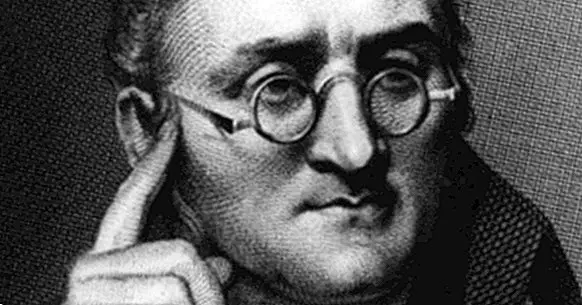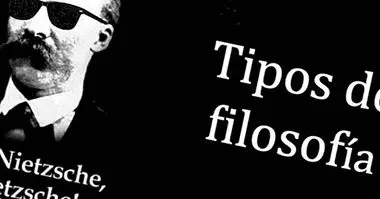The 9 postulates of Dalton's atomic theory
Today we all know that Matter is made up of small particles called molecules which in turn are configured by atoms of different elements (which at present are known to be constituted by different subatomic particles such as protons, neutrons and electrons).
But although precursors existed even in ancient Greece, it would not be until 1803 when the theory that matter is made up of basic and indivisible units that come together to form different compounds, would be elaborated at the scientific level. considering atoms said indivisible units and compound atoms, or what later Avogadro would call molecules, the compounds formed through them.
That is the Dalton's Atomic Theory , which elaborated different postulates or principles that tried to give an explanation to the configuration of the matter.
- Maybe you're interested: "The chemistry of love: a very powerful drug"
John Dalton: Brief Introduction to the Creator of Atomic Theory
The figure of John Dalton is widely known to be the founder of the atomic theory and also to investigate and publicize the alteration of the vision known as color blindness, which he also suffered. This scientist was born in Britain in 1766, the son of a working family with few resources. Despite the difficulties, Dalton would learn science and mathematics at school and even teach at the age of twelve. Eventually he would open and run a school, along with his brothers.
Subsequently He expanded his interest in various sciences such as astronomy and geography , coming to give lectures about it. He considered studying medicine, but would be discouraged by his environment. He conducted various research and publications in various areas, including meteorology or even grammar. One of those that is currently more known is the one that has to do with the lack of color perception that he himself suffered and which is currently known as color blindness.
I would also investigate other phenomena such as heat, the behavior of gases and different elements. His work in these last areas would lead him to reflect on the composition of matter, which would eventually lead to the development of atomic theory.
- Related article: "Color blindness: causes, symptoms, types and characteristics"
The Atomic Theory of Dalton
One of Dalton's most important and recognized contributions to the field of science is his conception of atomic theory. Said theory established a model that tried to explain the behavior of matter as well as the fact that the combination of different proportions of different substances can generate different compounds, explaining the composition of complex elements from different balances of other substances.
The various investigations that Dalton would carry out would induce him to think that all the matter is configured of compounds and elements , being the first formed by combinations of the second. There are a series of indivisible particles, the so-called atoms, which form the basis of the different particles and have different characteristics among themselves. Each of the elements is formed from atoms of different classes. Dalton's theory recovers concepts typical of philosophers of antiquity, such as the concept of the atom of the Greek Democritus, but with a meaning somewhat different from the original.
Thus, Dalton did not believe that all matter could be identified with a single substance, but that There were atoms of different types and characteristics, with weight being one of the most studied variables . In fact, the creator of the atomic theory came to establish a table of elements based on the weight attributed to each of the types of atoms known, such as hydrogen and oxygen (although the initial table was not correct due to lack of knowledge and difficulty in measuring the weight of the different particles with the techniques of that time). He is also due to the fact that hydrogen is considered the basic pattern when it comes to considering the atomic mass of each element, since it is the lightest element.
The postulates of Dalton
The atomic theory Dalton can be summarized based on a series of postulates , which are described below.
- The matter is entirely made up of atoms , units of indivisible matter that can neither be generated nor destroyed.
- The atoms of a specific element they have in all cases the same size, weight and qualities , all of them being equal to each other.
- The characteristics of the atoms of different elements they are also always different , possessing different characteristics.
- While they can be combined with other substances to form different compounds, the atoms themselves remain unchanged , not being able to be divided or destroyed.
- The compounds are formed thanks to the combination of the atoms of two or more different elements.
- The combination of different types of atoms It is carried out through simple relationships .
- The combination between two specific elements can give rise to different compounds depending on the proportions in which they are mixed .
- In chemical reactions it is possible to create, dissociate or transform molecules , these being a reorganization of the atoms that make up each compound.
- The same compound is always produced by the same proportion in the combination of atoms.
Some aspects that the most current evidences have contradicted
The atomic theory of Dalton has been one of the most important in science when describing the structure of matter. However, since the time when this theory was developed there have been many advances who have shown that some of the postulates defended by the author are not true.
For example, the fact that the atom is a basic and indivisible unit has been shown to be false, being able to distinguish within the atom different parts formed by subatomic structures such as protons, neutrons and electrons .
It has also been uncertain the fact that all atoms of the same substance have equal properties. We can find atoms of different electrical charge according to the balance between protons and electrons (what we know as ions), as well as different atomic masses of the same element (the isotopes).
A third aspect that has proved to be divergent with Dalton's atomic theory is the fact that atoms are unmodifiable, which has been denied with the arrival of fusion and nuclear fission .
Although the evidence has shown that some of the postulates are not completely true, Dalton's theory has laid the foundations of modern chemistry and has allowed a breakthrough in the understanding of matter and its behavior.
Bibliographic references:
- Gribbin, J. (2006). History of science: 1543-2001 (2nd edition). Barcelona: Crítica, S.L.
- Petrucci, R .; Harwood, W .; Herring, G. & Madura, J. (2007). General Chemistry. 9th ed. Upper Saddle River, New Jersey: Pearson Prentice Hall.
- Rosental, M. and Iudin, P. (1973). Philosophical Dictionary. Universe editions.
- Soledad, E. (2010). Chemistry and the atomic theory. General chemistry. UNED, 22-23.



















